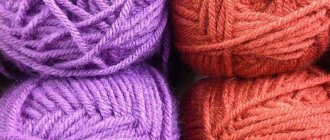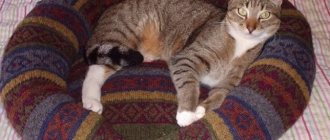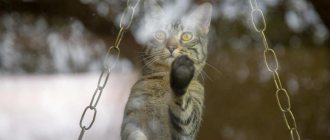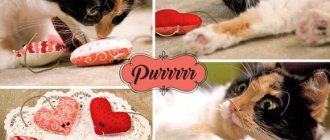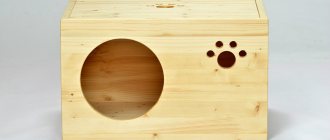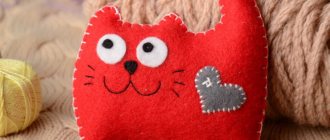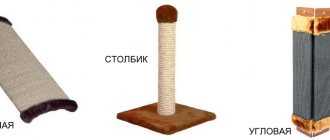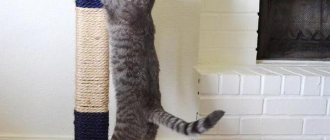SHARE ON SOCIAL NETWORKS
FacebookTwitterOkGoogle+PinterestVk
For a cat to feel like a full-fledged member of the family, he, like everyone else, needs to have a cozy corner where he can relax and unwind. There is always the opportunity to choose a ready-made option on store shelves, but a DIY cat bed will become not only attractive, but also an integral part of the interior. It is especially important that most product options do not require large investments of money or time.
Every cat should have its own comfortable sleeping place
Purpose
A separate sleeping structure for pets is a protective space where they will sleep peacefully and no one will disturb them. Organizing it for your pet will reduce the amount of hair on the furniture. There will be less hair on the owners’ clothes, and the apartment will be easier to clean. A cat bed solves many household problems.
In its cozy place, the pet will play and sharpen its claws, which will save the wallpaper and furniture upholstery that they so love to spoil. If the bed has sides, then the mother cat has the opportunity to rest there with her kittens.
Types of beds
To decide how to make a cat bed with your own hands, you need to understand what types there are. A place that resembles a heart shape, an oval, a circle, a rectangle - this is a small list of designs for this.
A small soft chair for relaxation with a height of more than 20 cm - called ottomans, which have a higher density. Animals really like poufs and they love to sleep on them.
A cat bed can resemble a bed with backs. It is possible to come up with various interesting configurations for it - a book, a huge shoe, etc. Hiding in secluded places during play is a favorite pastime for the cat breed.
You can make beds for cats with your own hands, reminiscent of a semi-house, where a small roof covers a comfortable soft bed. This place resembles a hole where the pet can hide from the owner's eyes.
In hammock beds with a large view, animals watch their household with interest.
How to choose
The favorite pastime of all purrs is to sleep sweetly. Cats can sleep in different places, so you need to choose a bed based on your pet’s personality. Observe your cat to see which type she will accept. For example, a warm, airy cheesecake is not always a plus for an animal. A furry pet living in a hot house will ignore the product. For long-haired pets who relax on sofas and armchairs, cat furniture is suitable, but in reduced sizes.
Semi-open houses are suitable for peaceful, smooth-haired creatures. In products with high sides, you can comfortably stretch out and take the most unimaginable sleeping positions. These loungers are available in a variety of designs and shapes, and are among the most popular. If the cat is unsociable and shy, it is better to consider the options of closed houses. Options in the form of soft caves for sleeping will appeal to those who do not like to be disturbed while sleeping. Such caves are well suited for kittens, who drag toys inside and make real holes. Pets who are used to sleeping next to their owner or wrapped in a diaper will appreciate their own blanket. Such sun loungers are equipped with soft mattresses and thick blankets. These beds will also be appreciated by hairless cats, pregnant animals, those with chronic diseases or elderly creatures.
For cats that literally sleep hugging the radiator, a radiator bed is suitable. The choice of these options is unlimited: there are cotton, lightweight models, as well as cozy fur products. An important detail of battery-powered models is their durable frames. If the rods are thin, they will lose their shape over time, and your pet may fall and get hurt. Some battery products are like barrels with fasteners. Experts do not recommend such models, since constant exposure inside leads to overheating, dryness and fragility of the skin, diseases of the mucous membranes and poor health. Such beds can be hung out sometimes, allowing the animal to warm up during especially cool periods.
Wicker products are known from other materials, but they are not very popular among pet owners. However, pets appreciate products made from natural materials and happily nap in such baskets. Wickers turn out to be so attractive that many animals chew on the rods, using their bed as a scratching post. To save their purchase, many owners upholster it with fabric. The base absorbs wool, loses its attractiveness, and is difficult to clean. It is better to immediately make the covers and pillows removable so that they can be washed.
Most models are suitable for both dogs and cats. Universal products are convenient, but you should choose them according to certain parameters.
- The quality of the base and tailoring. The durability of the product will be associated with these characteristics.
- The product must be machine washable. Cleanliness of the bed is an important aspect, but if the product cannot be washed in a machine, it will have to be done by hand.
- Product size.
- Form.
- Additional benefits. Some specimens are not only a place to sleep, but also an entire play complex. Manholes and attractive scratching posts will decorate your purrs' leisure time.
Available materials
When you want to please your pet, but sleeping places are expensive in the retail chain, it is advisable to sew a cat bed with your own hands from old clothes and fabrics available at home, according to the size of the animal, with a functional and roomy design.
The product must:
- do not be torn by the claws;
- stretch well;
- do not inject drugs;
- do not become electrified;
- do not attract dust.
The dimensions of the bed must be suitable for the size of the pet; the hardness of the pillow may vary. It is desirable that the product is in harmony with the overall interior of the living space.
The design requires a strong attachment so that it does not move when the pet first jumps. A depression inside is created if you do not completely fill the pillow with its contents.
Mattress for a cat
For the simplest mattress you will need two pieces of fabric and filling (sintepon). Such a lounger will protect armchairs and sofas from the need to constantly clean them of wool.
Cut out two identical pieces of fabric and place them right sides together. Sew on three sides and turn inside out.
Cut out the insulation from padding polyester, sized so that it fits tightly into the resulting “bag”.
Carefully fold the unsewn edges inward and stitch the last side of the bed. To prevent the filling from bunching up when washing, you can stitch the mattress several times along the front side.
Comfortable sofa for your pet
How to sew a cat bed with your own hands in the form of a spacious sofa? Take for sewing:
- wear-resistant fabric;
- thick rag bedding for the bottom;
- filler;
- sewing supplies.
Next, we make a pattern for a cat bed in the shape of two rectangles according to the required dimensions for the upper and lower parts. We cut out the sides in a rectangular shape of the required height: one for the length of the wall and 2 for the size of the sides. The front part is cut out in the form of two rectangles, only with a cutout for the entrance.
Next, we sew the sidewall on the back side, leaving an opening on one edge for laying holofiber. After filling the sides, they are stitched in a secret way.
We connect the bottom fabric and the bedding with a seam from the inside out, turn it inside out through one of the remaining slots and put the filling inside. We sew the cut manually. We place the bed-cushion in the prepared sofa from the sides.
Note!
DIY satin ribbon bows: photos of original design ideas, step-by-step DIY master class- DIY hair bands - ideas for decorating homemade rubber bands + step-by-step instructions for making them yourself
DIY shadow theater: step by step how to do it at home! 175 real photos
Wall routes
This is a recommendation for advanced users. If space allows, you can equip entire routes on the wall, consisting of multi-level shelves and equipped with hammocks and houses. The surface should be non-slip and suitable for sharpening claws.
In general, vertical spaces are very important for cats. Unlike people or dogs, cats are able to explore the entire area of a room, not just the floor or chair level.
By building vertical routes, you will expand the space available to the cat several times. In addition, she will feel safe upstairs when she wants to be alone.
Based on materials from registerguard.com
Bed made from worn jeans
A cat bed with a pattern of scraps from old jeans in two colors is made like this:
We are preparing additional materials: filling for the bottom and sides, an old terry towel for the bottom, or fleece fabric, sewing supplies.
We sew a side from 12 flaps of different colors of jeans 25x160 cm. To do this, we sew the strips on the wrong side, smooth them with an iron and sew a zigzag stitch on the outside to strengthen the seams.
Note!
DIY bracelets | Selection of the best models and master class on making beautiful bracelets- DIY bird feeder - interesting ideas on how to make it quickly and easily from scrap materials
- Do-it-yourself cold porcelain: the best options for porcelain products, step-by-step instructions and recipes for making it yourself (photo + video)
We cut out a circle from sewn large pieces of denim trousers, a circle of 48-50 cm, sew an applique into the center, which we turn off with a zigzag stitch on a sewing machine for strength.
We fold it in layers: an outer cover, a padding polyester on it, a layer of soft fabric, an outer upper cover and stitch it in a circle, as well as several times diagonally so that the padding polyester does not move.
We sew the edges of the side, leaving a hole for the padding polyester, and sew it with a machine to the assembled circle. Fill the side with padding polyester and sew up the hole.
Making a scratching post house
In the classic version, the scratching post is a pipe wrapped in jute rope. For stability, the pipe is filled with sand, placing it in a bag made of dense polyethylene. A bed with a scratching post made from a box is made using the following technology: a box of a suitable size is sealed with tape from the bottom, making an entry hole on two sides, and gluing the bottom of the box. The bottom folds are glued with hot melt adhesive or construction adhesive.
After this, the product is supplemented with foam rubber, followed by textiles. Then the structure can be glued to a larger wooden panel prepared in advance (for example, a sheet of chipboard). Next to the house they glue or insert the pipe into the hole made and fix it with glue. The scratching post is wrapped with twine, trying to do it as firmly and tightly as possible so that the cat cannot tear off the rope too quickly.
You can glue a small wooden panel to the top edge of the scratching post. It can also be supplemented with foam rubber and soft bedding, and, if desired, made with sides. So that the cat can play in this corner, it is recommended to supplement it with a fluffy ball, attaching it to a strong rope.
Lounger in the form of a house
It’s not difficult to make a cat bed with your own hands that resembles a small house. You will need: fleece fabric 1.5x1.5 m, synthetic padding 1.5x1.5 m, flexible powerful cord for the roof, sewing accessories.
Fold the fleece in half to a width of 0.3 m and cut off a length of 1 m - this will be the part for the roof. From padding polyester to insulate the top, we cut out a piece slightly smaller in size than the previous one for insulation.
We sew up the edges of the roof, except for one on the side, insert padding polyester there, distribute it evenly inside and sew it up with hidden seams. We quilt the roof lengthwise and crosswise to strengthen the structure.
To cut out the back part of the roof, bend it to the desired size and apply it to a piece of fabric, draw out a shape with chalk, cut out 2 parts, stitch them, connecting them along the circumference, turn the part inside out.
In the remaining cut we place a padding polyester, which is also cut according to the same pattern, only in a smaller size, then we sew up the cut with a hidden seam.
We cut out the bottom from fleece, or from artificial leather, line it with synthetic padding, cut the pillow on top to the shape and quilt the bottom.
Then we begin assembling the structure. First we sew the side to the roof, then we attach the bottom. We attach a cord along the edge of the roof from the inside to support the structure.
Structural elements and their location
To develop the design of a cat house with your own hands, you will have to work on drawings, diagrams and sketches.
- First you need to decide on the size and space. It is advisable to place the house where there is no draft, since cats are heat-loving animals.
- A small house for a cat can be easily moved from place to place, but it is better to choose a permanent location for it - the pet gets used to it and always knows where to find shelter.
- Preference should be given to environmentally friendly and safe materials. It is not recommended to use chemically impregnated wooden parts or synthetic fabrics. They do not allow air to pass through, but provide excellent breeding ground for all kinds of skin parasites.
- It is necessary to carefully cover all fastening points so that metal connections and screws do not protrude from under the fabric covering. This does not apply to cardboard and soft foam houses, but you will have to tinker with wooden structures.
In order to make a house for a cat with your own hands, the master should evaluate the instrumental capabilities. If you have electrical equipment at your disposal (a jigsaw, a drill, a milling cutter), then most often they decide to create a wooden structure or an entire play complex.
The presence of a sewing machine immediately brings to mind the idea of making a soft house from fabric and foam rubber. Well, for everyone else, what remains is cardboard, scissors and glue - also an interesting option for a budget home for your beloved pet.
Products made from paper tubes
How to make a bed for a cat if she really loves baskets. Weave it from waste paper and read newspapers, from which the tubes are rolled. A snowflake frame is assembled on a dense cardboard bottom. Next, it is braided around the perimeter with newspaper tubes to the desired height.
During the weaving process, the desired shape of the basket is selected. The ends of the newspaper tubes are inserted into each other to strengthen their connection. The edges of the structure are fixed with PVA glue.
The cat's house is decorated with various ribbons and fabrics, and toys. You can color it with animal-friendly food dyes.
Suspended structure
A DIY hanging bed for a cat will also please him. It is hung with a hook from vertical objects, as well as from the ceiling, and gives the interior of the room a special flavor.
First of all, you need to determine how many tiers are needed for this design. Based on this, you need to sew several small mattresses of the same or different sizes. The pads are connected using wide strips of fabric tied at the top for hanging.
Unnecessary sweater for a lounger
If your cat likes to sleep on an old sweater, then you can use it to design a sleeping place for your pet. You need to prepare: sewing supplies, scissors and stuffing. The neck of the sweater should be rolled or cut.
Next, you should make a line from one armpit to the other and sew up the cuffs to create a tube, which should be filled with filler. Then the ends of the sleeve are sewn together, the bottom of the sweater is sewn to the sides of the pipe, which is also filled with padding polyester. I made this cat bed with my own hands and it took very little time.
Hammocks for cat breeds
A hammock for a pet is made of fabric, which is attached at the corners to the base. The structure should not reach the floor; you can place it in your pet’s favorite place. It’s better to make it with an adjustable height and see which one is suitable for the cat.
For a hammock, you should initially choose a fabric fabric on which the cat liked to sleep. The hammock is attached to various supports, you can use an inverted stool, the pet will happily sleep on its favorite cloth.
The hammock is attached to the radiator in winter to keep your pet warm. To do this, a frame with hooks is made from strong wire, with the help of which the structure can be easily attached to the battery. The dimensions of the frame must correspond to the size of the animal.
A bed in the form of a cover with a clasp is sewn according to the size of the frame. You can also place a worn knitted half-over with folded sleeves and neckline on the wire outline.
Scratching posts
Cats love to sharpen their claws on different surfaces. In this way, they also mark their territory: special glands are located on their paw pads.
Offer your cat different scratching posts and see which she likes best. Some people prefer posts, others prefer vertical boards attached to the wall, and others prefer horizontal scratching posts of various shapes.
The materials are also varied: it can be plush, sisal, corrugated cardboard, wood.
Take a closer look at what your cat likes to sharpen her claws on. About the sofa? Then, most likely, she will like a vertical scratching post. Or carpet? Then choose horizontal shapes.
It is also important to choose the right location for the scratching post. It should be located where the cat prefers to sharpen its claws on other objects, spends a lot of time or plays
Slipper bed
Many of the cat breeds love to rest on their owner's slippers, so make a bed for them that resembles a slipper. To do this, you will need two pieces of thick fabric - 40x55 and 40x50 cm, filler, and sewing accessories.
We make a pattern: a large foot 55 cm long and 40 cm wide, the top of a slipper in the shape of a semicircle 40 cm high and 50 cm wide at the base. We cut out the parts in two pieces, sew them together, stuff them with filler. We sew up the seams with decorative stitching, and sew the top and bottom parts of the slipper.
Before purchasing expensive structures for resting cats and kittens in pet stores, try making them yourself. There are many unnecessary things at home that will make wonderful places for animals to rest, and then, based on their tastes and habits, you can pick up expensive equipment at the pet store so that the purchased item does not stand idle.
